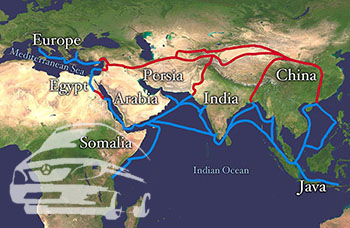The king of caravan routes – The Silk Road
Posted by Jerrard Romanoff in Guides, on October 22, 2015Before there was man and van there was the caravan. People had the need to move goods for commercial and purely domestic purposes since the dawn of time, and until not so long ago the well established and guarded caravan routes proved to be the most efficient way to do so, especially when it came to bringing precious items from distant lands.
 When one hears the name Silk Road, it is easy to imagine a single route that goes from point A to point B like a modern highway, but the truth is much more different. In fact, the Silk Road was a vast network that spanned over 6000 miles and connected Asia with Europe and Africa.
When one hears the name Silk Road, it is easy to imagine a single route that goes from point A to point B like a modern highway, but the truth is much more different. In fact, the Silk Road was a vast network that spanned over 6000 miles and connected Asia with Europe and Africa.
Actually, when you read more about the network, you will come to realize that even thousands of years ago the East and the West were tightly connected and exchange of goods, ideas and culture was no less active than it is today in the modern global society.
It is generally accepted that the origins of what we call Silk Road today are to be found during the beginning of the Han Dynasty in China, which was at the end of the 3rd century BC. Even though the name of the network comes from one of the most precious goods that was transported from China to Europe – the silk, very soon the road started serving the needs of merchants, pilgrims, monks, soldiers, nomads, and urban dwellers from China and India to the Mediterranean Sea, e.g. people from all walks of life with many and different purposes.
Curiously enough, it was the Chinese, not the Europeans that made the greatest contributions to the expansion of the network. Han Dynasty’s imperial envoy did much of the exploration of Central Asia that was crucial for finding the best routes for transportation of the precious goods – such that were both safe and quick. Very soon China was connected not only to the Middle and the Near East, but Europe as well, in addition to the Horn of Africa and the Arabian Peninsula. Chinese, Persians, Somalis, Greeks, Syrians, Romans, Armenians, Indians, and Bactrians were among the main nationalities traders on the Silk Road came from. As you can imagine yourself, the importance of such a network, connecting the most powerful civilizations in the ancient world, exceeded the purely economical benefits from the deal.
The Silk Road became an arena for exchanging political thought, culture and philosophical ideas. It opened the world in a such a way that can only be compared with the internet in the end of the 20th century. What is more important, it clearly shows that the world can be globalized and connected without the presence of modern technology. That is why the whole deal with the Silk Road is so interesting and captivating the imagination of both the general public and scholars and prompted UNESCO to designate the Chang’an-Tianshan corridor of the Silk Road as a World Heritage Site in 2014.
